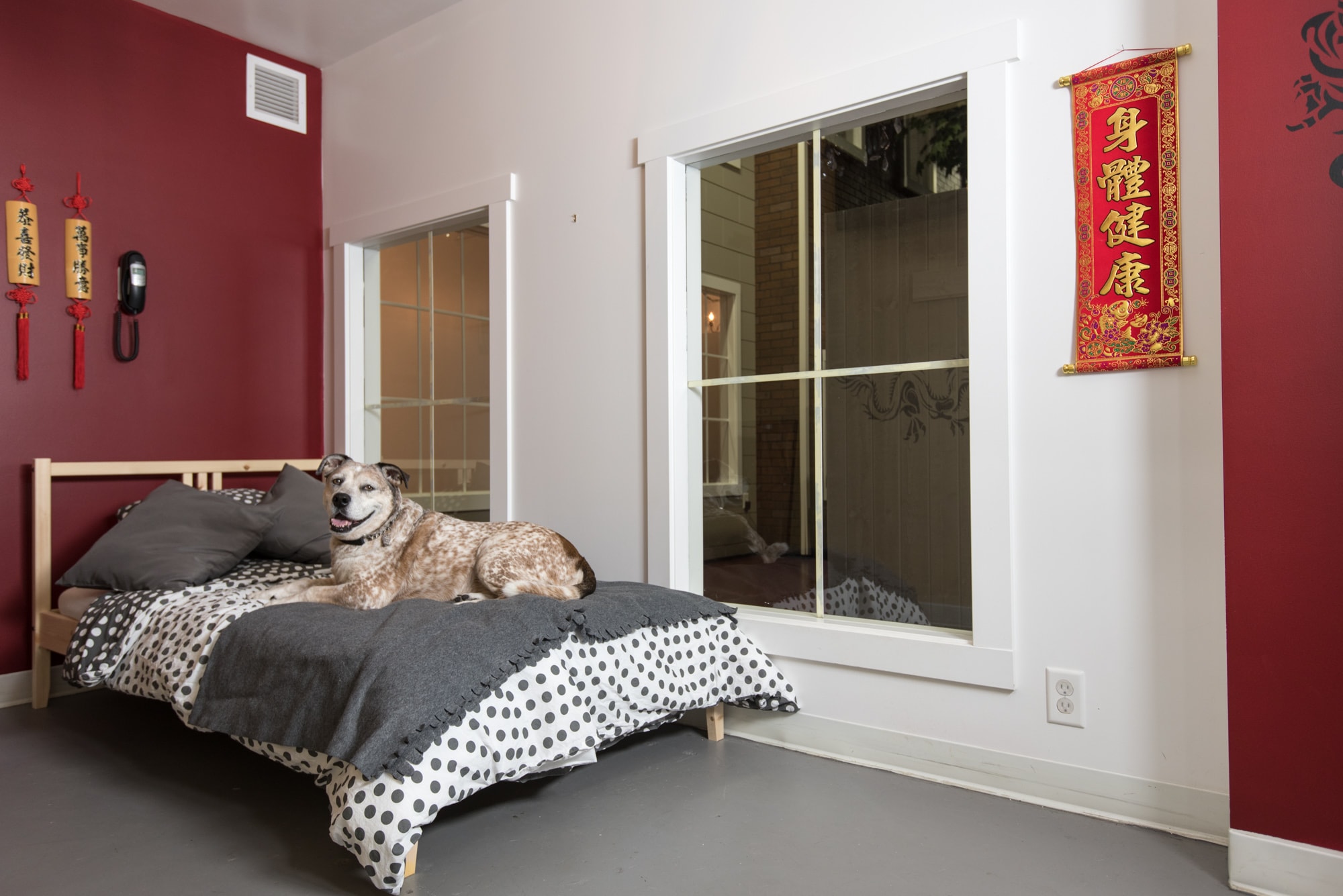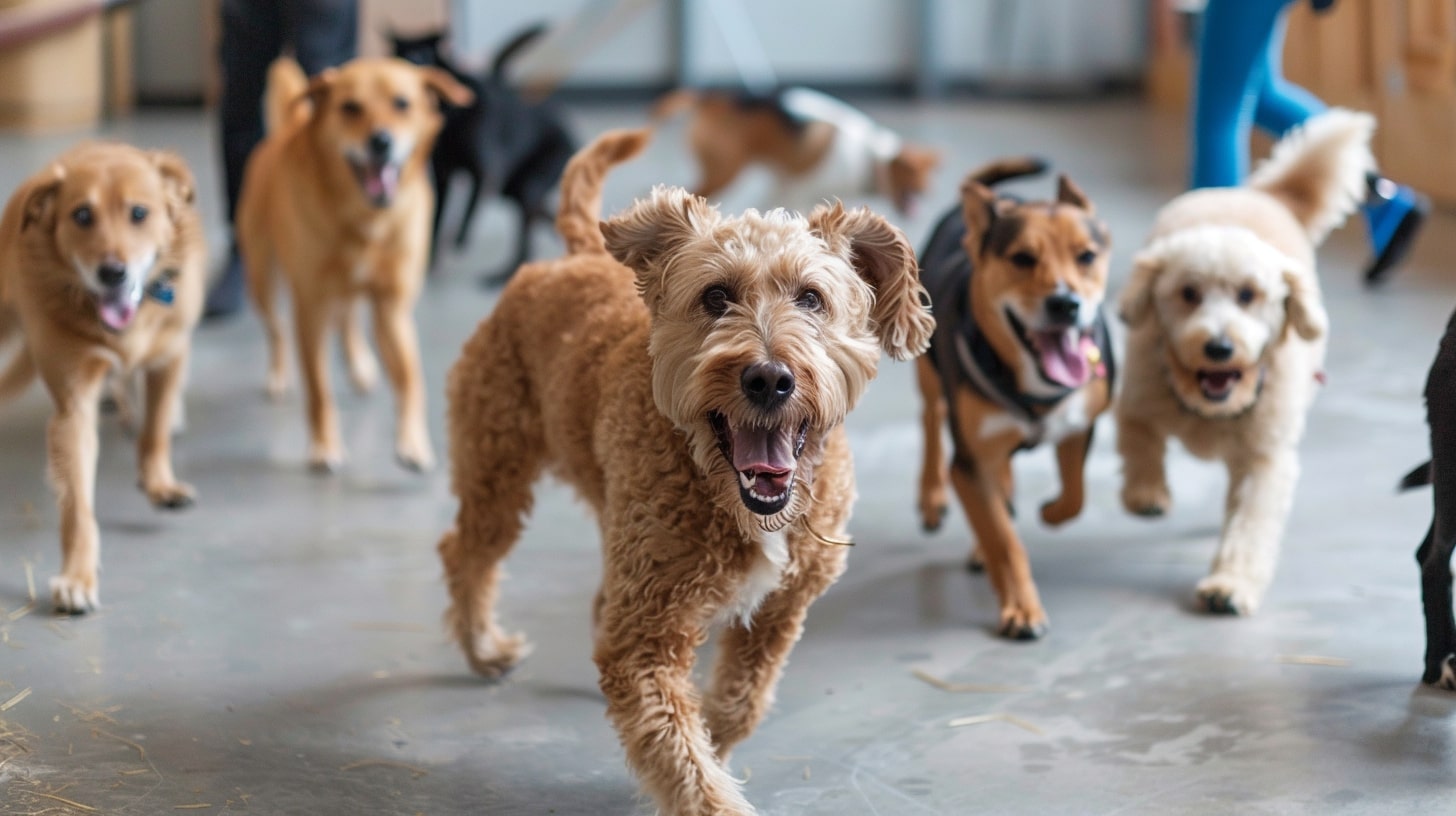
Dog Daycare vs Long Term Boarding: Compared
Dog Daycare
Dog daycare is a service designed to provide care, socialization, and exercise for dogs while their owners are at work or otherwise occupied. Think of it as a daycare for kids, but tailored to our furry friends. It’s a great way for dogs to get out of the house, interact with other dogs, and burn off some energy. Most dog daycare centres offer various activities to keep your pup entertained and happy throughout the day.
Types of Dog Daycare Services
Dog daycare services come in different shapes and sizes, catering to various needs and preferences. Let’s dive into the most common types:
Half-Day vs Full-Day Care
- Half-Day Care: Ideal for owners who only need a few hours of coverage. This option is usually more affordable and still provides plenty of playtime for your dog.
- Full-Day Care: Perfect for busy pet parents who work long hours. Your dog gets a full day of activities, socialization, and rest.
Indoor vs Outdoor Facilities
- Indoor Facilities: Typically found in urban areas, these facilities offer a controlled environment, which is great for dogs that might be sensitive to weather changes.
- Outdoor Facilities: These are often located in suburban or rural areas and provide ample space for dogs to run and play in the fresh air.
Typical Daily Routine in Dog Daycare
A typical day in dog daycare is structured to ensure that your dog is engaged and well-cared for. Here’s what a usual schedule might look like:
Playtime Activities
- Interactive Toys and Games: From fetch to tug-of-war, these activities help keep your dog’s mind and body active.
- Group Play Sessions: Dogs are grouped based on size, temperament, and play style to ensure safe and enjoyable interactions.
Rest Periods
- Nap Times: To prevent overstimulation, dogs are given designated rest periods throughout the day. These naps help them recharge and stay calm.
- Quiet Zones: Areas where dogs can retreat if they need some alone time or a break from the excitement.
Feeding Schedules
- Meal Times: If your dog has specific feeding times or dietary needs, daycare staff will accommodate these to keep your pup on their regular schedule.
- Treats and Rewards: Many daycares incorporate treats as part of positive reinforcement during play and training sessions.
Benefits of Dog Daycare
Dog daycare offers numerous benefits that can improve your dog’s overall well-being:
Socialization
- Interaction with Other Dogs: Regular playdates with other dogs can help improve your dog’s social skills and reduce behavioural issues.
- Meeting New People: Being around different caregivers and other pet owners helps your dog become more adaptable and less anxious around strangers.
Physical Exercise
- Daily Exercise: Ensures your dog gets the physical activity they need to stay healthy and fit.
- Weight Management: Regular play can help prevent obesity and related health issues.
Mental Stimulation
- Puzzle Toys and Challenges: Activities designed to engage your dog’s brain and keep them mentally sharp.
- New Experiences: Exposure to different environments, sounds, and smells can help reduce boredom and anxiety.
Drawbacks of Dog Daycare
While dog daycare has many benefits, it’s essential to consider potential drawbacks:
Cost Considerations
- Expense: Regular daycare can be pricey, especially if you need full-day care every day. It’s crucial to budget accordingly.
- Additional Fees: Some centres may charge extra for specific services like grooming or training sessions.
Potential for Overstimulation
- Too Much Play: Some dogs may become overly excited or exhausted from constant interaction, leading to stress or behavioural issues.
- Noise Levels: Daycare environments can be noisy, which might not be suitable for dogs that are sensitive to sound.
Long-Term Boarding

Long-term boarding is designed for situations where you need to leave your dog for extended periods, such as vacations or business trips. Unlike daycare, boarding facilities provide overnight accommodations and round-the-clock care. This service ensures that your dog’s needs are met while you’re away, giving you peace of mind.
Types of Boarding Facilities
There are several types of boarding facilities, each offering different levels of care and amenities:
Traditional Kennels
- Basic Accommodations: Dogs are kept in individual kennels or runs. They receive regular meals, exercise, and interaction with staff.
- Affordability: Often more budget-friendly than luxury options, making them accessible for longer stays.
Luxury Pet Hotels
- Upscale Amenities: These facilities offer high-end services, such as spacious suites, premium bedding, and even TV and music to keep your dog entertained.
- Additional Services: Many luxury hotels provide grooming, training, and spa services, ensuring your dog is pampered during their stay.
In-Home Boarding
- Home-Like Environment: Your dog stays in a caregiver’s home, providing a more personal and less stressful experience.
- Individual Attention: Typically fewer dogs are boarded at once, allowing for more one-on-one attention and customized care.
Typical Daily Routine in Long-Term Boarding
Long-term boarding facilities strive to maintain a consistent routine to help your dog feel comfortable and secure:
Exercise and Playtime
- Scheduled Walks: Regular walks and exercise sessions ensure your dog stays active and healthy.
- Playgroups: Opportunities for socialization with other dogs in a controlled environment.
Feeding and Medication Administration
- Meal Schedules: Boarding facilities adhere to your dog’s regular feeding schedule and accommodate special dietary needs.
- Medication Management: Trained staff can administer medications as required, ensuring your dog’s health needs are met.
Sleeping Arrangements
- Comfortable Bedding: Dogs are provided with comfortable bedding, and some facilities offer options to bring familiar items from home to ease anxiety.
- Climate Control: Facilities are equipped to maintain a comfortable temperature, ensuring your dog’s comfort regardless of the weather.
Benefits of Long-Term Boarding
Long-term boarding offers several advantages for both you and your dog:
Comprehensive Care
- Professional Supervision: Your dog is cared for by trained professionals who can handle any health or behavioural issues that arise.
- Routine and Structure: Consistent routines help reduce stress and anxiety for dogs during extended stays.
24/7 Supervision
- Round-the-Clock Monitoring: Staff are available at all times to ensure your dog’s safety and well-being.
- Emergency Care: Facilities are equipped to handle emergencies and have protocols in place for quick response.
Safe and Controlled Environment
- Secure Premises: Boarding facilities are designed to prevent escapes and ensure the safety of all dogs in their care.
- Controlled Interactions: Socialisation is managed carefully to avoid conflicts and ensure positive experiences.
Drawbacks of Long-Term Boarding
Consider these potential downsides before choosing long-term boarding:
Higher Cost
- Expense: Boarding for extended periods can be costly, particularly in luxury facilities.
- Additional Charges: Be aware of extra fees for services like grooming, training, or special dietary requirements.
Less Personal Attention
- Shared Attention: In traditional kennels, staff must divide their attention among multiple dogs, which may mean less individual interaction for your pet.
- Adjustment Period: Some dogs may take time to adjust to the boarding environment, especially if they are not used to being away from home.
Adjustment Period for Dogs
- Separation Anxiety: Dogs who are very attached to their owners might experience anxiety when left in boarding facilities.
- Behavioural Changes: It’s not uncommon for some dogs to exhibit behavioural changes due to the new environment and routine.
Key Differences Between Dog Daycare and Long-Term Boarding

When deciding between dog daycare and long-term boarding, it’s essential to understand the key differences to make the best choice for your pet:
| Aspect | Daycare | Boarding |
|---|---|---|
| Purpose | Provides daily care and socialization for pets. | Offers overnight or extended stay accommodations for pets. |
| Duration | Typically during daytime hours, similar to a child’s daycare. | Includes overnight stays, often for several days or weeks. |
| Availability | Open during business hours, usually 8-12 hours a day. | Available 24/7 for extended stays, including weekends and holidays. |
| Environment | Interactive, social environment with other pets. | Individual or shared accommodations, often with more quiet time. |
| Socialization | High level of social interaction with other pets. | Varies; some facilities offer group play, others focus on individual care. |
| Staff Interaction | Regular interaction with staff throughout the day. | Consistent staff care but may have less frequent interaction than daycare. |
| Exercise | Multiple play and exercise sessions throughout the day. | Scheduled exercise and playtimes, but possibly less frequent than daycare. |
| Feeding Schedule | Typically follows pet owner’s feeding schedule, usually once or twice. | Set feeding times, can be customized but follows facility’s schedule. |
| Rest Time | Nap or quiet times included but less frequent. | More structured rest periods, including overnight sleep. |
| Medical Care | Basic first aid and medication administration. | Comprehensive care, often with on-call veterinary services. |
| Suitability | Ideal for pets needing daytime activity and socialization. | Best for pets requiring care during owner’s extended absence. |
| Cost | Generally lower daily rates compared to boarding. | Higher cost due to overnight stays and extended care. |
| Behavioural Requirements | Pets should be well-socialized and non-aggressive. | Can accommodate a wider range of behaviours with proper management. |
| Owner’s Schedule | Suitable for owners with regular daytime commitments. | Suitable for owners travelling or unable to care for pets overnight. |
| Flexibility | Drop-off and pick-up typically required daily. | Flexible drop-off and pick-up times, accommodating extended trips. |
| Amenities | Play areas, toys, group activities. | Private sleeping areas, sometimes luxury accommodations, extra services (grooming, training). |
| Common Issues | Separation anxiety, need for social pets. | Potential stress from extended absence of owner, adjustment to new environment. |
Duration of Stay
- Dog Daycare: Typically a daily service where dogs are dropped off in the morning and picked up in the evening. Ideal for short-term needs.
- Long-Term Boarding: Designed for extended stays, such as vacations or business trips. Provides overnight accommodations and continuous care.
Cost Comparison
- Dog Daycare: Generally more affordable on a daily basis. Costs can add up if used frequently.
- Long-Term Boarding: Higher costs due to the extended care and additional services provided.
Types of Services Offered
- Dog Daycare: Focuses on daily activities, playtime, and socialization. Limited overnight services.
- Long-Term Boarding: Comprehensive care including feeding, medication administration, exercise, and overnight accommodations.
Socialization Opportunities
- Dog Daycare: Excellent for dogs that enjoy interacting with other dogs and people. Regular playgroups and activities.
- Long-Term Boarding: Offers socialization but in a more controlled environment. Interaction may be less frequent compared to daycare.
Level of Supervision
- Dog Daycare: Supervision during operating hours. Less intensive monitoring.
- Long-Term Boarding: 24/7 supervision ensuring constant care and attention.
Choosing the Right Option for Your Dog

Choosing between dog daycare and long-term boarding depends on several factors unique to your dog and your circumstances. Here’s how to make an informed decision:
Assessing Your Dog’s Needs
Consider your dog’s age, health, and temperament when deciding between daycare and boarding:
Age and Health Considerations
- Puppies and Senior Dogs: May require more frequent attention and care, making daycare a better option for daily needs.
- Healthy Adult Dogs: Often do well in both settings, depending on their socialization and activity levels.
Temperament and Socialization
- Sociable Dogs: Thrive in daycare environments with plenty of interaction.
- Anxious or Aggressive Dogs: Might do better in a more controlled boarding environment with individualized care.
Evaluating Your Schedule and Budget
Your lifestyle and financial situation will also play a significant role in your decision:
Time Commitment
- Busy Schedules: Daycare can be a convenient daily solution if you work long hours.
- Travel Requirements: Long-term boarding is essential for extended trips or vacations.
Financial Considerations
- Budget Constraints: Daycare might be more economical for regular, short-term needs.
- Willingness to Spend: Boarding offers comprehensive care but at a higher cost, suitable for longer absences.
Researching and Visiting Facilities
Thorough research and visits to potential facilities are crucial:
Reading Reviews and Testimonials
- Online Reviews: Look for feedback from other pet owners to gauge the quality of care.
- Word of Mouth: Ask friends, family, or your vet for recommendations.
Touring the Facility
- Inspection: Visit the facility to ensure it meets your standards for cleanliness, safety, and comfort.
- Meet the Staff: Interact with the caregivers to assess their expertise and approach to pet care.
Trial Visits and Adjustments
Before committing, consider a trial run:
- Short Stays: Test the facility with a short stay to see how your dog adapts.
- Feedback: Pay attention to how your dog behaves during and after the visit to determine their comfort level.
Practical Tips for a Smooth Experience

Ensuring a smooth experience for both you and your dog involves preparation and clear communication. Here are some practical tips:
Preparing Your Dog for Daycare or Boarding
Getting your dog ready for daycare or boarding can make the transition smoother and reduce anxiety:
Vaccination and Health Requirements
- Vaccinations: Ensure your dog’s vaccinations are up to date. Most facilities require proof of vaccinations for rabies, distemper, parvovirus, and Bordetella.
- Health Check: A recent health check-up can identify any underlying issues that might affect your dog’s stay.
Packing Essentials
- Familiar Items: Pack your dog’s favourite toys, blankets, or bedding to provide comfort and a sense of home.
- Food and Medication: Provide enough food for the duration of the stay, along with clear feeding instructions. Include any necessary medications with detailed administration guidelines.
Communicating with Care Providers
Effective communication with daycare or boarding staff ensures your dog receives the best care:
Clear Instructions
- Routine Details: Share your dog’s daily routine, including feeding times, exercise preferences, and any specific behavioural quirks.
- Emergency Contacts: Provide contact information for yourself and a backup person, as well as your veterinarian’s details.
Regular Updates
- Check-Ins: Arrange for regular updates on your dog’s well-being, either through phone calls, texts, or photos.
- Feedback: Encourage staff to report any changes in your dog’s behaviour or health immediately.
Monitoring Your Dog’s Behaviour and Well-Being
Keep an eye on your dog’s behaviour to ensure they are adapting well to the new environment:
Post-Stay Assessment
- Behaviour Changes: Monitor your dog for any signs of stress or discomfort after their stay. Changes in eating habits, sleeping patterns, or mood can indicate issues.
- Follow-Up Visits: If your dog had a positive experience, plan regular visits to reinforce their comfort and familiarity with the facility.
Final Thoughts
Choosing between dog daycare and long-term boarding depends on your dog’s specific needs, your schedule, and budget. By understanding the key differences and carefully evaluating facilities, you can make an informed decision that ensures your dog’s happiness and well-being.
FAQs
- What is the average cost of dog daycare vs long-term boarding?
- Dog daycare typically costs $20-$40 per day, while long-term boarding ranges from $50-$100 per night, depending on the facility and services offered.
- How can I tell if my dog enjoys daycare or boarding?
- Look for signs of excitement when arriving at the facility, a healthy appetite, and a relaxed demeanour after returning home.
- What should I do if my dog gets sick while boarding?
- Ensure the facility has your vet’s contact information and an emergency plan in place. Communicate with the staff regularly for updates on your dog’s condition.
- Are there any alternatives to daycare and long-term boarding?
- Alternatives include hiring a pet sitter, arranging for a friend or family member to care for your dog, or using in-home boarding services.
- How can I ensure my dog is getting enough exercise while boarding?
- Choose a facility that offers regular exercise sessions and playtime. Discuss your dog’s exercise needs with the staff and ensure they have a structured routine.
